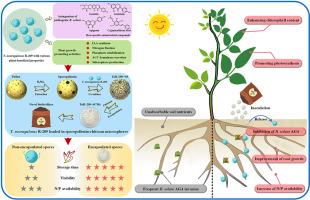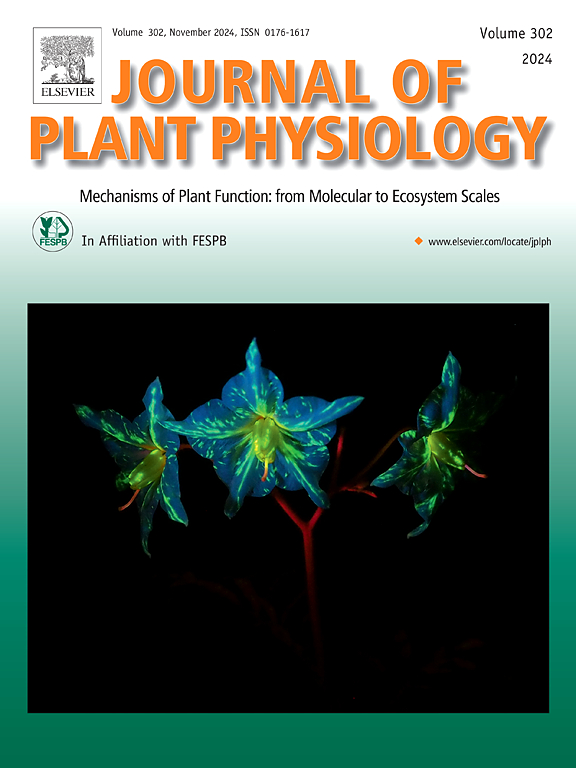Sporopollenin-chitosan microspheres loaded with an endophytic fungus Talaromyces neorugulosus R-209 for promoting development and controlling root rot in pigeon pea
IF 4.1
3区 生物学
Q1 PLANT SCIENCES
引用次数: 0
Abstract
Plant-beneficial microbes can be effective as biological agents for promoting development and controlling diseases in plants. However, direct inoculation of non-encapsulated plant-beneficial microbes into the soils can affect their vitality and efficacy. A novel bio-based encapsulant, sporopollenin-chitosan microspheres (SCMs), was developed to load an endophytic fungus Talaromyces neorugulosus R-209 with antagonistic activities against the root rot pathogen (Rhizoctonia solani AG4) and plant growth-promoting functions. The results showed that T. neorugulosus R-209 encapsulated in SCMs (TnR-209−SCMs) could significantly enhance fungal spore germination rates and available nitrogen/phosphorus levels in the soil compared to the non-encapsulated fungus. In addition, the preliminary evidence suggests that TnR-209−SCMs have a basic safety profile for practical applications. Inoculation with TnR-209−SCMs could effectively promote development and enhance resistance in pigeon pea seedlings by promoting chlorophyll synthesis, improving photosynthesis, and enhancing phenolic compound accumulation. Meanwhile, T. neorugulosus R-209 was found to endogenously colonize root intercellular spaces. Moreover, co-inoculation of TnR-209−SCMs and R. solani AG4 could reduce host defense responses compared to R. solani AG4-infected roots, as reflected by lower levels of phenolic compound accumulation and pathogenesis-/biosynthesis-related gene expression. Overall, TnR-209−SCMs is a promising biological agent that can promote development and control root rot in plants, which also provides an innovative approach to biomaterial-supported agricultural practices.

载内生真菌Talaromyces neoruglosus R-209的孢粉素-壳聚糖微球促进木豆发育和防治根腐病
植物有益微生物是促进植物发育和控制病害的有效生物制剂。然而,将非包膜植物有益微生物直接接种到土壤中会影响其活力和功效。研究了一种新型的生物基包封剂——孢粉素-壳聚糖微球(SCMs),该微球对内生真菌Talaromyces neoruglosus R-209具有拮抗根腐病病菌(Rhizoctonia solani AG4)和促进植物生长的作用。结果表明,与未包封真菌相比,经SCMs包封的T. neorugulosus R-209 (TnR-209−SCMs)能显著提高真菌孢子萌发率和土壤有效氮磷水平。此外,初步证据表明,TnR-209−SCMs在实际应用中具有基本的安全性。接种TnR-209−SCMs可以通过促进叶绿素合成、促进光合作用、促进酚类化合物积累等方式,有效促进鸽豆幼苗发育,增强抗性。同时发现T. neorugulosus R-209在根细胞间隙内源性定殖。此外,与茄茄AG4感染根相比,共接种TnR-209−SCMs和茄茄AG4可以降低宿主的防御反应,这反映在酚类化合物积累水平和发病机制/生物合成相关基因表达水平较低。总的来说,TnR-209−SCMs是一种很有前景的生物制剂,可以促进植物的生长和控制根腐病,这也为生物材料支持的农业实践提供了一种创新的方法。
本文章由计算机程序翻译,如有差异,请以英文原文为准。
求助全文
约1分钟内获得全文
求助全文
来源期刊

Journal of plant physiology
生物-植物科学
CiteScore
7.20
自引率
4.70%
发文量
196
审稿时长
32 days
期刊介绍:
The Journal of Plant Physiology is a broad-spectrum journal that welcomes high-quality submissions in all major areas of plant physiology, including plant biochemistry, functional biotechnology, computational and synthetic plant biology, growth and development, photosynthesis and respiration, transport and translocation, plant-microbe interactions, biotic and abiotic stress. Studies are welcome at all levels of integration ranging from molecules and cells to organisms and their environments and are expected to use state-of-the-art methodologies. Pure gene expression studies are not within the focus of our journal. To be considered for publication, papers must significantly contribute to the mechanistic understanding of physiological processes, and not be merely descriptive, or confirmatory of previous results. We encourage the submission of papers that explore the physiology of non-model as well as accepted model species and those that bridge basic and applied research. For instance, studies on agricultural plants that show new physiological mechanisms to improve agricultural efficiency are welcome. Studies performed under uncontrolled situations (e.g. field conditions) not providing mechanistic insight will not be considered for publication.
The Journal of Plant Physiology publishes several types of articles: Original Research Articles, Reviews, Perspectives Articles, and Short Communications. Reviews and Perspectives will be solicited by the Editors; unsolicited reviews are also welcome but only from authors with a strong track record in the field of the review. Original research papers comprise the majority of published contributions.
 求助内容:
求助内容: 应助结果提醒方式:
应助结果提醒方式:


